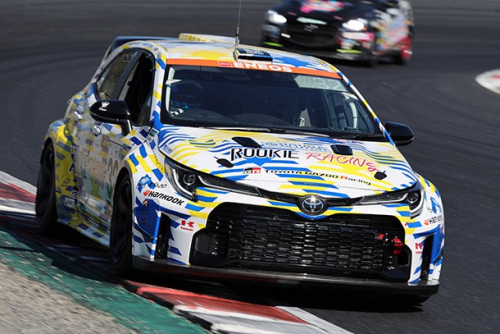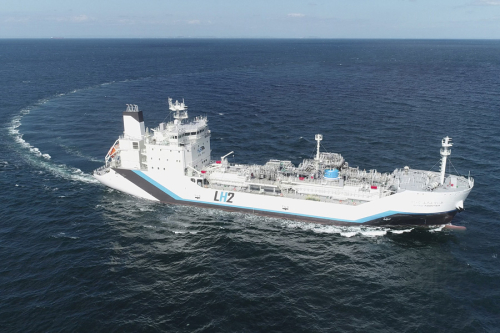In March, Toyota’s GR Corolla H2 Concept (liquid hydrogen-powered Corolla) suffered a fire during a tet run and withdrew from the opening of the ENEOS Super Taikyu Series 2023 Powered by Hankook Round 1 Suzuka. (Earlier post.)
Now, Toyota says that with the Super Taikyu season kicking off at Suzuka Circuit in Mie Prefecture, the first race for its liquid hydrogen-powered GR Corolla will be the Fuji 24 Hours in May—a 24-hour endurance race that is the most grueling event of the series.

Toyota says that the fire was caused by a loosened joint in the hydrogen supply piping. Hydrogen leaked from the joint and ignited, burning the surrounding plastic parts.
The leak occurred at the joint nearest to the engine, where it is exposed to the engine’s movement and vibration as the car accelerates or slows down. At the same time, the incident also demonstrated that the safety equipment was functioning properly, shutting down the hydrogen supply in less than 0.1 second. As a result, the fire was extinguished before it could spread, and no one was injured.
In addition to revising the structure of the joint, the team will modify the design to isolate it from heat sources and stop the flow of hydrogen in the event of a leak.
=In explaining the chain of events, Toyota continued to emphasize a key point: the fire was caused by a design issue and did not mean that hydrogen was inherently dangerous.
Given a spark, gasoline will burn in any environment. Hydrogen, on the other hand, only ignites at certain concentrations and temperatures. Specifically, it needs a 4% concentration in air and a temperature of at least 550 ˚C—that is, hydrogen will not ignite under any other conditions.
—GAZOO Racing Company President Tomoya Takahashi
This car competes in the ST-Q class, a category set up with the goal of developing technology that will play a part in creating our future mobility society. The purpose of such testing is to identify issues. Getting a car running on liquid hydrogen at racing speeds is something no one in the world has ever done before.
The key is figuring out how to build on the issues that emerge. We plan to keep moving forward with continuous improvement.
—Toyota President Koji Sato
I see it as par for the course in the world of racing. We undertook this effort to help create a hydrogen society. As we’ve said from the outset, the future will be shaped by acting with purpose and passion. Even as the engineers say it can’t be done, they’ve managed to develop the technology in an agile way while competing well and keeping an eye on what’s going on around us.
I drive the car myself, and we’re not giving up on the project. I want people to see hydrogen not as a danger, but as our future.
—Toyota Chairman Akio Toyoda
The mobile liquid hydrogen station that will be used at the circuit is being developed by Iwatani Corporation. By using liquid hydrogen as fuel, equipment that was previously necessary to produce compressed gaseous hydrogen such as compressors and pre-coolers for cooling hydrogen are no longer needed. As a result, the station can be four times smaller compared to stations for gaseous hydrogen, and fuel can be refilled in the pit area in the same way as gasoline-powered vehicles. In addition, since there is no longer the need to pressurize when filling, multiple vehicles can be filled in succession.
Kawasaki Heavy Industries joined Toyota’s Super Taikyu endeavor in 2021 as a partner transporting Australian hydrogen and has expanded its efforts from there. Kawasaki President Yasuhiko Hashimoto used the example of liquefied natural gas (LNG) to explain the potential of liquid hydrogen.

All of you probably regard LNG as an everyday source of energy. And yet, when I joined Kawasaki in 1981 and we built Japan’s first large LNG carrier, the reaction was, “What are you going to do with that? Why bother liquefying gas for transport? Who is going to use something so expensive?” Nonetheless, LNG has become indispensable in the push to increase the world’s energy options.
Hydrogen is very similar to natural gas, so that anything running on natural gas can easily be converted to hydrogen. It can also be turned into electricity. We can also explore new possibilities as a substitute for gasoline. Given its excellent combustibility, I think hydrogen shows great promise for use in engines.
We believe it is following the same trajectory once taken by LNG.
—Yasuhiko Hashimoto